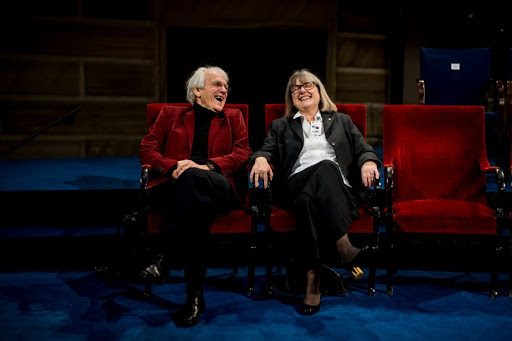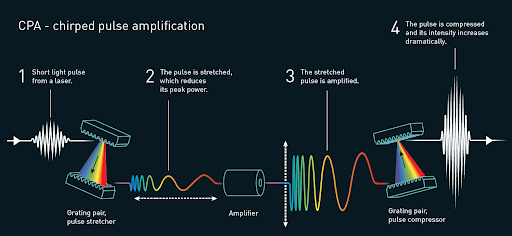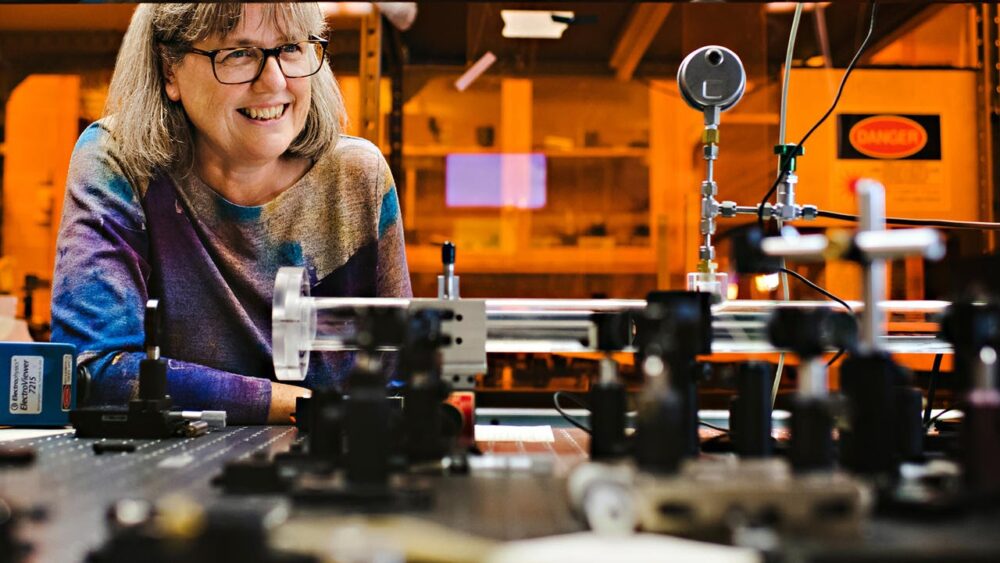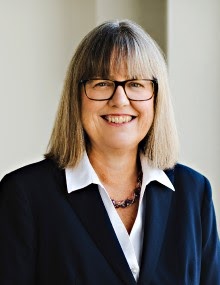“We proved that we could increase laser intensity by orders of magnitude. In fact, CPA led to the most intense laser pulses ever recorded. Our findings changed the world’s understanding of how atoms interact with high-intensity light.”
“Gérard Mourou, who was my PhD supervisor, dreamed up the idea of increasing laser intensity by orders of magnitude. He did it while he was on a ski trip with his family. He probably shouldn’t have been thinking about lasers.”
- Donna Strickland
Dr. Donna Strickland, is a professor in the Department of Physics and Astronomy at the University of Waterloo. She received the Nobel Prize in Physics in 2018 for her work on lasers. The prize was shared with her PhD supervisor Gérard Mourou, who worked with her to develop the new laser technology back in the 1980s. This achievement was the work of her PhD thesis while at the University of Rochester. Both Strickland and Mourou worked to broaden our understanding of how lasers operate, and it also unravelled a new breakthrough in the field – they were able to exceed the power limit of a laser beam with the shortest pulse. The beam gets stretched out and then amplified with energy, then this same beam gets compressed into a very short pulse, thus creating the shortest laser pulse with the highest intensity ever made. This new technology became known as Chirp Pulse Amplification.
Hassan: Your work on lasers is groundbreaking in the field of physics, specifically, optics and light. Can we first start off with what lasers are? And how are they made?

Nobel Media. Photo: A. Mahmoud
Donna: Lasers are sources of coherent optical radiation. Coherence means that the waves have no phase jumps on average over a period of time given by the coherence time. Incoherent light from the sun or a desk lamp has coherence times of no more than a couple of periods of oscillation. The laser can have coherence lengths of millions of optical periods. The coherence time is inversely proportional to the spectral bandwidth.
Lasers have four components to make them work. First, you need the gain medium. Second, a pump source to excite the atoms in the gain medium. Third, is the optical cavity, which plays a number of roles. It selects the cavity modes – both spectral and spatial. The modes give the coherence. The optical cavity also allows the beam to travel several times through the gain medium so that the gain is extracted. Finally, the fourth component of a laser is the output coupler. One of the cavity mirrors cannot be a 100% reflector or no light would leave the laser. One of the mirrors will have a small transmission and that allows the beam to exit the laser.
The coherence of a laser comes from two things. First, the light is amplified by stimulated emission, which is the deexcitation of an excited atom by a photon yielding a second photon having the same energy, momentum and phase. However, this is not sufficient as the stimulated emission process has a bandwidth given by the lifetime of the excited state. Secondly, the bandwidth of laser light is further restricted by placing the gain material inside an optical cavity often composed of two mirrors. The cavity only allows modes where integer multiples of half the wavelength equals the cavity length. You can have a single mode laser which has the longest coherence length if the bandwidth of the stimulated emission is less than the wavelength separation of the modes. The bandwidth of this single mode is given by the inverse of the average time the photons remain in the cavity, which is determined by the cavity losses of which the main loss is typically caused by the transmission of the output coupler. The spatial coherence is also set up by the cavity as it requires the modes to exist across the entire spatial profile and this generates the spatial mode, which is typically a gaussian beam.
Hassan: Can you explain briefly what was your contribution to the field of lasers?

Donna: My main contribution was the co-development of Chirped Pulse Amplification. This development allowed short pulses to be amplified to large energies for the first time. This is needed for applications requiring high peak power which is given by the energy divided by the pulse duration.
Hassan: Alfred Nobel wrote in his will on the Nobel prize, “prizes to those who, during the preceding year, have conferred the greatest benefit to humankind.” What are the applications of your new laser technology?
Donna: The main application used today concerns machining transparent objects. Before CPA, laser machining occurred because the laser light was absorbed causing a thermal reaction. With the high intensity of CPA, the interaction is a nonlinear ionization. This interaction is highly intensity dependent and so is much stronger at the focal point. You can focus a beam inside a transparent medium such as glass or the cornea of an eye and cause this ionization inside the medium only where the beam is focused. This process is used to cut a flap in the cornea by scanning the focused beam over an area inside the cornea. The same process is used to cut very small holes in glass parts used in things such as cell phones.
Hassan: The name of your new discovery is called Chirp Pulse Amplification. What does “chirp” mean here?
Donna: Chirp means that frequency changes with time. In order to amplify a short pulse, you must first make it a long pulse so the peak power does not get too high in the amplifier. The peak power divided by the beam area is known as the laser intensity. If the laser intensity gets too high, the beam can start to self-focus. This means the beam gets even smaller and the intensity increases causing the self-focusing to be a run-away phenomenon. Thus, causing beam collapse that causes damage in the laser amplifiers. We used dispersion which causes different frequencies to travel at different speeds. After travelling through a normally dispersive medium, the lower energy or redder colours will have moved out ahead of the peak of the pulse and the higher energy or bluer colours will have lagged behind the pulse. The pulses were then chirped red to blue which is known as a positive chirp. The pulse is then necessarily longer than if all the colours had travelled together to remain with the peak of the pulse.
Hassan: In your laser invention, you succeeded in making short intense pulses of light. In order to be able to do that, you needed a lot of colors to make the pulse short. Can you elaborate on why that is?

Nobel Foundation
Donna: A purely single wavelength is a wave that exists for all time. This comes from Fourier transform theory. The intensity of a single wavelength would be a constant as a function of time. If you add two different wavelengths, the intensity would vary sinusoidally with the beat frequency given by the difference in the two frequencies. If you add several frequencies that are all separated by a given frequency difference you get a pulse train, where the time between the pulses is the inverse of the frequency separation. The duration of the pulses is inversely proportional to the total bandwidth, which would be given by the frequency separation times the number of frequency modes. For the pulse to be very short, you need a very large spectrum. The opposite of a single frequency giving an infinite pulse length or coherence time, is that an infinitesimally short pulse would need an infinitely wide frequency spectrum.
Hassan: How did it feel to receive the Nobel prize?
Donna: It is hard to explain how it feels. It is an exciting but surreal experience. You cannot believe you are winning it. It is a life changing experience. The most surreal moment for me was when I was asked to sign the book in the Nobel Foundation that has all signatures of all the Nobel prize winners. Before they had me sign the book, they showed me the signatures of Albert Einstein and Marie Curie. I couldn’t believe that I was signing the same book.
Hassan: What do you have to say to young people who are passionate about science and the natural world?
Donna: I think people who get to work on something they are passionate about are very lucky people and they shouldn’t take the opportunity for granted. It can be frustrating when the answers don’t come easily, but we have to remember that the questioning is the experience to be relished and the exploration of new ideas is the fun of science.
Hassan: When the Nobel Committee announced the 2018 Nobel prize winner for physics, they wrote “Donna Strickland, the third woman in history to win the Nobel Prize in Physics.” What advice do you have to women in science?
Donna: I don’t have different advice for women than men. I think we all have to know for ourselves what we really want to do. Then we should all try to do it to the best of our ability. We must take pride in our own achievements whether or not they are recognized by others.
Hassan: I have looked up your PhD thesis and it was only three pages long, yet it is a very well written paper. Do you think simplicity is necessary in science? Or sometimes things need to be hard and lengthy in order to be understood?
Donna: My first paper that won the Nobel prize was only 3 pages. My PhD thesis was quite a bit longer and was not only about developing CPA but also using CPA to investigate multiphoton ionization at ultrahigh intensities.
Thank you for thinking my paper was well written. Papers seem to get longer over time. If you go back to the sixties, many optical technology papers were only half a page with probably only one reference (we were less concerned with citation counts back then).

A paper must be written so a reader is able to copy the experiment or calculation and get the same result. It is up to the author to give enough details to make that happen. It depends on the topic how much needs to be written to explain the idea.
































